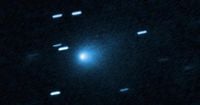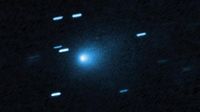As the summer of 2025 unfolds, astronomers and skywatchers around the world have their eyes set on a rare and enigmatic visitor: 3I/ATLAS, the third known interstellar object to barrel through our solar system. In a series of recent breakthroughs, NASA’s Hubble Space Telescope has delivered the most detailed images yet of this cosmic wanderer, igniting excitement, speculation, and a fresh wave of scientific inquiry.
Discovered on July 1, 2025, by a telescope in Chile, 3I/ATLAS immediately caught the attention of astronomers due to its unmistakably foreign trajectory. Within a day, NASA confirmed that this icy body hailed from beyond our solar system, following in the wake of two previous interstellar interlopers: the elongated ‘Oumuamua, spotted in 2017, and comet Borisov, discovered in 2019. According to NASA, these objects are so rare that only a handful have ever been observed, making each appearance a scientific goldmine.
On July 21, 2025, Hubble captured a striking image of 3I/ATLAS as it passed 277 million miles from Earth, orbiting at a brisk pace of more than 130,000 mph (210,000 km/h). The image, released on August 7 by NASA and the European Space Agency, shows a “teardrop-shaped cocoon of dust” trailing from what scientists believe is a solid, icy nucleus. This cocoon, along with a faint dusty tail, is typical of comets, but 3I/ATLAS is anything but ordinary.
Early size estimates for the nucleus ranged up to 20 kilometers across, but Hubble’s sharp eye has narrowed that figure to between 1,000 feet (320 meters) and 3.5 miles (5.6 kilometers). Even at the upper end, that would make 3I/ATLAS the largest interstellar object ever observed, dwarfing both ‘Oumuamua and Borisov. "The solid heart of the comet presently cannot be directly seen, even by Hubble," NASA noted, but the data have been instrumental in refining these estimates, now accepted for publication in Astrophysical Journal Letters.
But what truly sets 3I/ATLAS apart isn’t just its size or speed. As reported by New Scientist, ground-based telescopes and the Neil Gehrels Swift Observatory have detected a surprisingly large amount of water vapor emanating from the comet—even at great distances from the sun where such activity is uncommon. Zexi Xing of Auburn University and her colleagues found that about 20% of the comet’s surface must be actively releasing water, a much larger fraction than typically seen in solar system comets. This unusual behavior suggests that 3I/ATLAS may have formed in a star system billions of years older than our own, where water is more abundant relative to other molecules.
Supporting this theory, astrophysicists Aster Taylor and Darryl Seligman (University of Michigan and Michigan State University, respectively) proposed that the comet could be anywhere from three to 11 billion years old. They cite its immense speed—estimated at 134,000 mph relative to the Sun—as evidence of its ancient, galaxy-spanning journey. "Since the influence of the galaxy tends to speed up objects over time, this velocity implies that ATLAS is far older," the pair wrote in an editorial for Space.com.
As the comet approaches the sun, its dust tail is growing, a phenomenon familiar to astronomers studying comets from our own solar system. Toni Santana-Ros from the University of Barcelona and his team observed that, aside from its interstellar origin, 3I/ATLAS behaves much like a typical comet. “It’s a regular object. There is nothing especially weird on it,” Santana-Ros told New Scientist. Yet the sheer amount of water it releases, and how early this activity began, continues to puzzle researchers. Cyrielle Opitom of the University of Edinburgh noted, “It might be that it has more water than other molecules just because it was formed earlier. It could be indicative of that, but I think it’s still too early to say.”
Adding to the intrigue, the Transiting Exoplanet Survey Satellite (TESS), designed to hunt for exoplanets, accidentally captured 3I/ATLAS between May 7 and June 3, 2025. Adina Feinstein of Michigan State University and her colleagues found the comet to be surprisingly bright during this period, implying significant outgassing of water or other volatiles far from the sun. This suggests that 3I/ATLAS may not have been exposed to much starlight previously, consistent with an origin in the outer reaches of its home star system. Matthew Genge of Imperial College London speculated, “What it all ultimately suggests is this is a comet that was perturbed out of the outskirts of another solar system.”
Yet, for all the scientific consensus, there is still room for speculation. Harvard professor Avi Loeb, known for his provocative theories, told CBS Mornings Plus that the comet’s characteristics are “not typical” and its trajectory is “fine-tuned.” Loeb even suggested that 3I/ATLAS could be alien technology, citing its unusual glow and the lack of a typical comet tail. “Not assuming anything, just monitoring it and deciding whether it maneuvers, whether it has some artificial lights, whether it looks like a technological object, and if it ends up being a comet, so be it,” Loeb remarked. However, most astronomers, including Santana-Ros, see no evidence supporting this idea. “Since we don’t have any evidence that this is some weird thing, and we are not seeing anything really weird, then there is no reason to think this is something abnormal,” Santana-Ros explained.
As 3I/ATLAS continues its journey, it will make its closest approach to the sun in late October 2025, passing safely on the far side between the orbits of Mars and Earth. The comet should remain visible to telescopes through September, but will then disappear behind the sun, reemerging for renewed observations in early December. According to the Las Cumbres Observatory in Chile, all three known interstellar objects “appear to be quite dark and red, reflecting only about 5% of the sunlight that hits them, which is similar in reflectivity to asphalt.” Unlike ‘Oumuamua, which changed brightness as it rotated, 3I/ATLAS appears more spherical, as its brightness remains steady.
Looking ahead, astronomers are eager for more data. The James Webb Space Telescope has just completed new observations of 3I/ATLAS, and scientists hope these will shed further light on its composition and origins. Each interstellar object, as Wes Fraser of the National Research Council Canada put it to Live Science, “is a little piece of low-hanging fruit from a tree that can tell us a great deal about the trees growing in some other neighborhood.”
For now, 3I/ATLAS remains a fleeting but invaluable messenger from the distant corners of our galaxy, offering tantalizing clues to the origins of water, comets, and perhaps even life itself.






